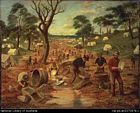- Occupation
- Artist
From all accounts, it would appear that Edwin Roper Loftus Stocqueler was present on the Bendigo goldfields during the mid 1850s. Stocqueler could be described as the archetypal mid-nineteenth century traveller, who recorded his journeys in watercolour, oil and pencil. Although few of his works remain, his surviving paintings serve as a visual record of the colonial period. Contemporary newspaper reports indicate he had broad interests, encompassing natural history and the environment. Of particular interest is his seminal work ‘Castlemaine from Ten Feet Hill’ a work that provides an accurate image of the emergent city of Castlemaine during its formative years.
His detailed paintings, particularly of the narrative surrounding the early discovery of gold, provide specific details of daily life on the diggings. For example, the oil painting titled ‘Australian gold diggings c.1855’ is a colourful depiction of miners panning, cradling and digging for gold. In this work, Stocqueler provides a detailed narrative within a shallow valley: the viewer can observe the vigorous activity of miners against a backdrop of canvas tents. Other artists of this period, including S.T. Gill and George Lacy, portrayed various aspects of life on the diggings with humour; Edwin Stocqueler, however, adopted a realistic approach, unconsciously conveying the environmental impact of alluvial gold mining.


